Analysis of the Effects of Local Regulations on the Preservation of Water Resources Using the CA-Markov Model
Abstract
1. Introduction
2. Materials and Methods
2.1. Study Area
2.2. Data Collection
3. Methodology
3.1. Major Local Regulations and Design of Effectiveness Analysis
3.2. LUCC Prediction
3.2.1. CA-Markov Model
3.2.2. Land Change Prediction and Validity Review
4. Results and Discussion
4.1. Land Changes during 1989–1999 and 1999–2013 and the Transition Sub-Model
4.2. Result of the BNN and TPM
4.3. Prediction Results and the Effectiveness of Local Regulation
5. Conclusions
Funding
Institutional Review Board Statement
Informed Consent Statement
Data Availability Statement
Conflicts of Interest
References
- Geist, H.J.; Lambin, E.F. Proximate causes and underlying driving forces of tropical deforestation. Bioscience 2002, 52, 143–150. [Google Scholar] [CrossRef]
- Ali, H. Land Use and Land Cover Change, Drivers and Its Impact: A Comparative Study from Kuhar Michael and Lenche Dima of Blue Nile and Awash Basins of Ethiopia. Ph.D. Thesis, Cornell University, New York, NY, USA, 2009. [Google Scholar]
- Singh, S.K.; Mustak, S.; Srivastava, P.K.; Szabó, S.; Islam, T. Predicting spatial and decadal LULC changes through cellular automata Markov chain models using earth observation datasets and geo-information. Environ. Process. 2015, 2, 61–78. [Google Scholar] [CrossRef]
- Francesch-Huidobro, M.; Dabrowski, M.; Tai, Y.; Chan, F.; Stead, D. Governance challenges of flood-prone delta cities: Integrating flood risk management and climate change in spatial planning. Prog. Plann. 2017, 114, 1–27. [Google Scholar] [CrossRef]
- Robi, M.A.; Abebe, A.; Pingale, S.M. Flood hazard mapping under a climate change scenario in a Ribb catchment of Blue Nile River basin, Ethiopia. Appl. Geomat. 2019, 11, 147–160. [Google Scholar] [CrossRef]
- Zampella, R.A.; Procopio, N.A.; Lathrop, R.G.; Dow, C.L. Relationship of Land-Use/Land-Cover Patterns and Surface-Water Quality in the Mullica River Basin. JAWRA 2007, 43, 594–604. [Google Scholar] [CrossRef]
- Meneses, B.M.; Reis, R.; Vale, M.J.; Saraiva, R. Land use and land cover changes in Zêzere watershed (Portugal)—Water quality implications. Sci. Total Environ. 2015, 527, 439–447. [Google Scholar] [CrossRef]
- Shi, P.; Zhang, Y.; Li, Z.; Li, P.; Xu, G. Influence of land use and land cover patterns on seasonal water quality at multi-spatial scales. Catena 2017, 151, 182–190. [Google Scholar] [CrossRef]
- Dezhkam, S.; Amiri, B.J.; Darvishsefat, A.A.; Sakieh, Y. Performance evaluation of land change simulation models using landscape metrics. Geocarto Int. 2017, 32, 655–677. [Google Scholar] [CrossRef]
- Hwang, J.H.; Park, S.H.; Song, C.M. A Study on an Integrated Water Quantity and Water Quality Evaluation Method for the Implementation of Integrated Water Resource Management Policies in the Republic of Korea. Water 2020, 12, 2346. [Google Scholar] [CrossRef]
- Hasan, S.; Shi, W.; Zhu, X.; Abbas, S.; Khan, H.U.A. Future Simulation of Land Use Changes in Rapidly Urbanizing South China Based on Land Change Modeler and Remote Sensing Data. Sustainability 2020, 12, 4350. [Google Scholar] [CrossRef]
- Hamad, R.; Balzter, H.; Kolo, K. Predicting Land Use/Land Cover Changes Using a CA-Markov Model under Two Different Scenarios. Sustainability 2018, 10, 3421. [Google Scholar] [CrossRef]
- Salem, M.; Tsurusaki, N.; Divigalpitiya, P. Analyzing the Driving Factors Causing Urban Expansion in the Peri-Urban Areas Using Logistic Regression: A Case Study of the Greater Cairo Region. Infrastructures 2019, 4, 4. [Google Scholar] [CrossRef]
- Ansari, A.; Golabi, M.H. Prediction of spatial land use changes based on LCM in a GIS environment for Desert Wetlands—A case study: Meighan Wetland, Iran. Int. Soil Water Conserv. Res. 2019, 7, 64–70. [Google Scholar] [CrossRef]
- EGIS: Environment Geographic Information Service. Available online: https://egis.me.go.kr (accessed on 5 November 2020).
- Ruben, G.B.; Zhang, K.; Dong, Z.; Jun, X. Analysis and Projection of Land-Use/Land-Cover Dynamics through Scenario-Based Simulations Using the CA-Markov Model: A Case Study in Guanting Reservoir Basin, China. Sustainability 2020, 12, 3747. [Google Scholar] [CrossRef]
- Omar, N.Q.; Ahamad, M.S.S.; Hussin, W.M.A.W.; Samat, N.; Ahmad, S.Z. Markov CA, Multi Regression, and Multiple Decision Making for Modeling Historical Changes in Kirkuk City, Iraq. J. Indian Soc. Remote Sens. 2013, 42, 165–178. [Google Scholar] [CrossRef]
- WAMIS: Water Management Information System, National Institute of Environmental Research. Available online: https://www.water.nier.go.kr (accessed on 7 November 2020).
- NTIC: National Transport Information Center. Available online: https://intl.its.go.kr/en/02_05_09 (accessed on 11 November 2020).
- Arnold, J.G.; Allen, P.M.; Bernhardt, G. A comprehensive surface-groundwater flow model. J. Hydrol. 1993, 142, 47–69. [Google Scholar] [CrossRef]
- Young, R.A.; Onstad, C.A.; Bosch, D.D.; Anderson, W.P. AGNPS: A Nonpoint Source Pollution Model for Evaluating Agricultural Watersheds. J. Soil Water Conserv. 1989, 44, 168–173. Available online: https://www.jswconline.org/content/44/2/168 (accessed on 1 March 2021).
- Rossman, L.A. Storm Water Management Model User’s Manual, 5th ed.; Water Supply and Water Resources Division National Risk Management Research Laboratory, Office of Research and Development: Cincinnati, OH, USA, 2010; p. 276.
- Aisha, M.S. Evaluation of SWAT Model Applicability for Water Impairment Identification and TMDL Analysis. Ph.D. Thesis, University of Maryland, College Park, MD, USA, 30 October 2007. [Google Scholar]
- EPA. Storm Water Management for Industrial Activities. Pollution Prevention Plans and Best Management Practices; Office of Water-EPA: Washington, DC, USA, 1993.
- Wanielista, M.P.; Yousef, Y.A.; McLellon, W.M. Nonpoint source effects on water quality. Water Pollut. Control Fed. 1977, 49, 441–451. Available online: https://www.jstor.org/stable/25039287 (accessed on 12 February 2021).
- NIER. Technical Guidelines for TMDLs; Korean Literature; National Institute Environment Research: Incheon, Korea, 2014.
- Parsa, V.A.; Yavari, A.; Nejadi, A. Spatio-temporal analysis of land use/land cover pattern changes in Arasbaran Biosphere Reserve: Iran. Model. Earth Syst. Environ. 2016, 2, 1–13. [Google Scholar] [CrossRef]
- Liu, Y.; Dai, L.; Xiong, H. Simulation of urban expansion patterns by integrating auto-logistic regression, Markov chain and cellular automata models. J. Environ. Plan. Manag. 2015, 58, 1113–1136. [Google Scholar] [CrossRef]
- Hsu, L.C. Applying the Grey prediction model to the global integrated circuit industry. Technol. Forecast. Soc. Chang. 2003, 70, 563–574. [Google Scholar] [CrossRef]
- Weng, Q. Land use change analysis in the Zhujiang Delta of China using satellite remote sensing, GIS and stochastic modelling. J. Environ. Manag. 2002, 64, 273–284. [Google Scholar] [CrossRef] [PubMed]
- Mishra, V.N.; Rai, P.K.; Mohan, K. Prediction of land use changes based on land change modeler (LCM) using remote sensing: A case study of Muzaffarpur (Bihar), India. J. Geogr. Inst. Jovan Cvijic SASA 2014, 64, 111–127. [Google Scholar] [CrossRef]
- Murugesan, S.; Zhang, J.; Vittal, V. Finite state Markov chain model for wind generation forecast: A data-driven spatiotemporal approach. In Proceedings of the 2012 IEEE PES Innovative Smart Grid Technologies (ISGT), Washington, DC, USA, 16–20 January 2012; pp. 1–8. [Google Scholar] [CrossRef]
- Kumar, S.; Radhakrishnan, N.; Mathew, S. Land use change modelling using a Markov model and remote sensing. Geomat. Nat. Hazards Risk 2014, 5, 145–156. [Google Scholar] [CrossRef]
- Behera, M.D.; Borate, S.N.; Panda, S.N.; Behera, P.R.; Roy, P.S. Modelling and analyzing the watershed dynamics using Cellular Automata (CA)-Markov model—A geo-information based approach. J. Earth Syst. Sci. 2012, 121, 1011–1024. [Google Scholar] [CrossRef]
- Khawaldah, H.A. A Prediction of Future Land Use/Land Cover in Amman Area Using GIS-Based Markov Model and Remote Sensing. J. Geogr. Inf. Syst. 2016, 8, 412–427. [Google Scholar] [CrossRef]
- Faichia, C.; Tong, Z.; Zhang, J.; Liu, X.; Kazuva, E.; Ullah, K.; Al-Shaibah, B. Using RS Data-Based CA-Markov Model for Dynamic Simulation of Historical and Future LUCC in Vientiane, Laos. Sustainability 2020, 12, 8410. [Google Scholar] [CrossRef]
- Subedi, P.; Subedi, K.; Thapa, B. Application of a Hybrid Cellular Automaton-Markov (CA-Markov) Model in Land-Use Change Prediction: A Case Study of Saddle Creek Drainage Basin, Florida. Appl. Ecol. Environ. Sci. 2013, 1, 126–132. [Google Scholar] [CrossRef]
- Ye, B.; Bai, Z. Simulating land use/cover changes of Nenjiang County based on CA-Markov model. Comput. Technol. Agric. 2008, 1, 321–329. [Google Scholar] [CrossRef]
- Reddy, C.S.; Singh, S.; Dadhwal, V.K.; Jha, C.S.; Rao, N.R.; Diwakar, P.G. Predictive modelling of the spatial pattern of past and future forest cover changes in India. J. Earth Syst. Sci. 2017, 126. [Google Scholar] [CrossRef]
- Tajbakhsh, S.M.; Memarian, H.; Moradi, K.; Aghakhani Afshar, A.H. Performance comparison of land change modeling techniques for land use projection of arid watersheds. Glob. J. Environ. Sci. Manag. 2018, 4, 263–280. [Google Scholar] [CrossRef]
- Clark Labs. TerrSet Geospatial Monitoring and Modeling Software. Available online: https://clarklabs.org/terrset/ (accessed on 3 July 2020).
- Eastman, J.R. Idrisi Taiga Manual; Clark Lab, Clark University: Worcester, MA, USA, 2009. [Google Scholar]
- Eastman, J.R. Idrisi TerrSet 18.00; Clark University: Worcester, MA, USA, 2014. [Google Scholar]
- Eastman, J.R.; Crema, S.C.; Rush, H.R.; Zhang, K. A weighted normalized likelihood procedure for empirical land change modeling. Model. Earth Syst. Environ. 2019, 5, 985–996. [Google Scholar] [CrossRef]
- Landis, J.R.; Koch, G.G. The Measurement of Observer Agreement for Categorical Data. Biometrics 1977, 33, 159–174. [Google Scholar] [CrossRef]
- Song, C.M. Hydrological Image Building Using Curve Number and Prediction and Evaluation of Runoff through Convolution Neural Network. Water 2020, 12, 2292. [Google Scholar] [CrossRef]
- Kim, D.Y.; Song, C.M. Developing a Discharge Estimation Model for Ungauged Watershed Using CNN and Hydrological Image. Water 2020, 12, 3534. [Google Scholar] [CrossRef]
- Alqurashi, A.; Kumar, L. Investigating the use of remote sensing and GIS techniques to detect land use and land cover change: A review. Adv. Remote Sens. 2013, 2, 193–204. [Google Scholar] [CrossRef]
- E Silva, L.P.; Xavier, A.P.C.; da Silva, R.M.; Santos, C.A.G. Modeling land cover change based on an artificial neural network for a semiarid river basin in northeastern Brazil. Glob. Ecol. Conserv. 2020, 21, e00811. [Google Scholar] [CrossRef]
- Pérez-Vega, A.; Mas, J.F.; Ligmann-Zielinska, A. Comparing two approaches to land use/cover change modeling and their implications for the assessment of biodiversity loss in a deciduous tropical forest. Environ. Model. Softw. 2012, 29, 11–23. [Google Scholar] [CrossRef]
- Oñate-Valdivieso, F.; Bosque Sendra, J. Application of GIS and remote sensing techniques in generation of land use scenarios for hydrological modeling. J. Hydrol. 2010, 395, 256–263. [Google Scholar] [CrossRef]
- Xiao, J.; Shen, Y.; Ge, J.; Tateishi, R.; Tang, C.; Liang, Y.; Huang, Z. Evaluating urban expansion and land use change in Shijiazhuang, China, by using GIS and remote sensing. Landsc. Urban Plan. 2006, 75, 69–80. [Google Scholar] [CrossRef]
- Hassan, Z.; Shabbir, R.; Ahmad, S.S.; Malik, A.H.; Aziz, N.; Butt, A.; Erum, S. Dynamics of land use and land cover change (LULCC) using geospatial techniques: A case study of Islamabad Pakistan. SpringerPlus 2016, 5, 1–11. [Google Scholar] [CrossRef] [PubMed]
- Kogo, B.K.; Kumar, L.; Koech, R. Analysis of spatio-temporal dynamics of land use and cover changes in Western Kenya. Geocarto Int. 2021, 36, 376–391. [Google Scholar] [CrossRef]
- Nixon, D.V.; Newman, L. The efficacy and politics of farmland preservation through land use regulation: Changes in southwest British Columbia’s Agricultural Land Reserve. Land Use Policy 2016, 59, 227–240. [Google Scholar] [CrossRef]
- Subiyanto, S.; Fadilla, L. Monitoring land use change and urban sprawl based on spatial structure to prioritize specific regulations in Semarang, Indonesia. IOP Conf. Ser. Earth Environ. Sci. 2018, 179, 012029. [Google Scholar] [CrossRef]
- Li, M. The effect of land use regulations on farmland protection and non-agricultural land conversions in China. Aust. J. Agric. Resour. Econ. 2019, 63, 643–667. [Google Scholar] [CrossRef]
- Zhang, J. Historical changes in the land use regulation policy system in Beijing since 1949. J. Appl. Sci. 2012, 12, 2202–2214. [Google Scholar] [CrossRef]
- Kalkidan, A.; Hailu, W.; Mekuria, A. Assessing the impact of watershed land use on Kebena river water quality in Addis Ababa, Ethiopia. Environ. Syst. Res. 2021, 10. [Google Scholar] [CrossRef]
- Nafi’Shehab, Z.; Jamil, N.R.; Aris, A.Z.; Shafie, N.S. Spatial variation impact of landscape patterns and land use on water quality across an urbanized watershed in Bentong, Malaysia. Ecol. Indic. 2021, 122, 107254. [Google Scholar] [CrossRef]
- Rajib, M.A.; Ahiablame, L.; Paul, M. Modeling the effects of future land use change on water quality under multiple scenarios: A case study of low-input agriculture with hay/pasture production. Sustain. Water Qual. Ecol. 2016, 8, 50–66. [Google Scholar] [CrossRef]
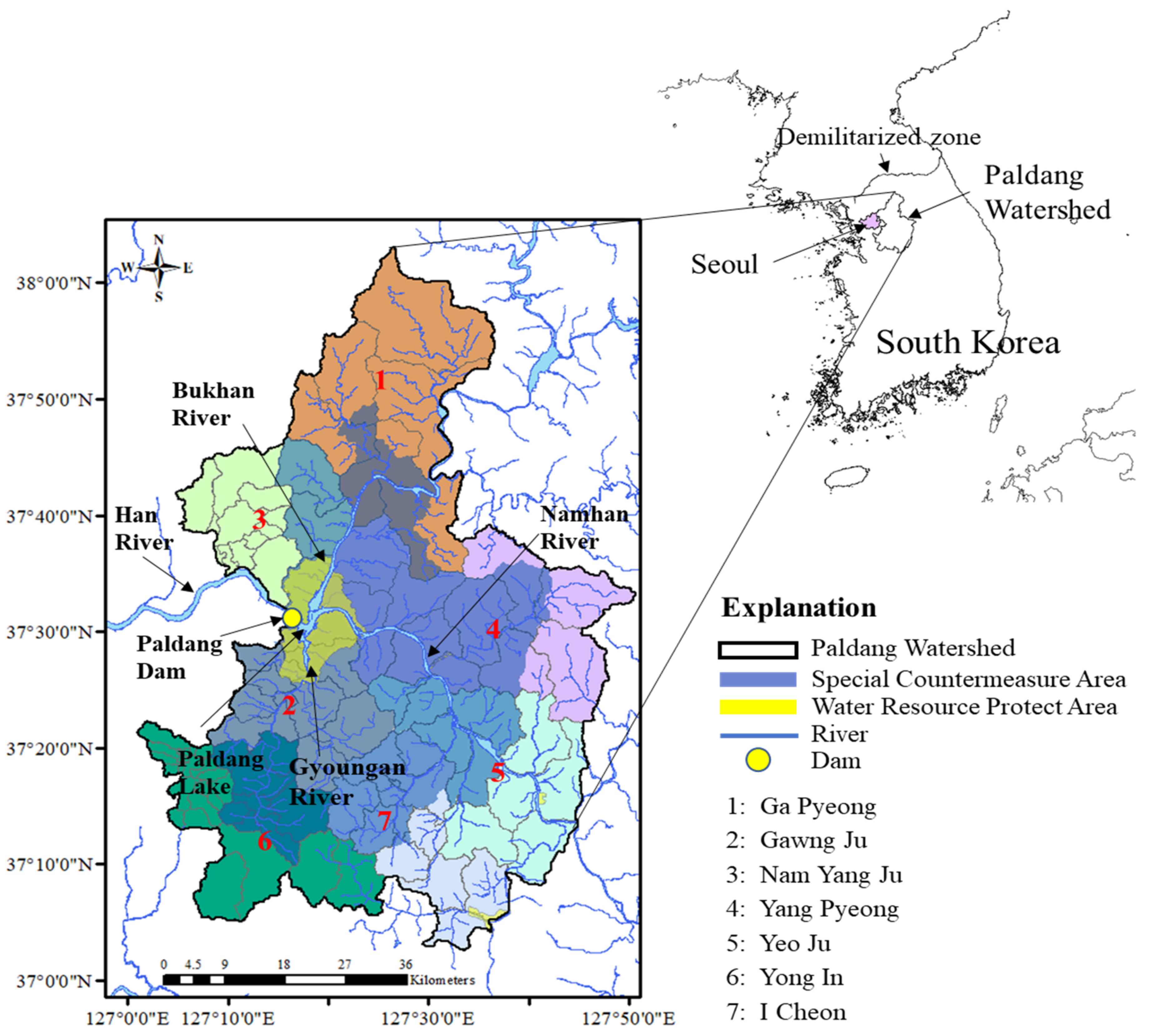

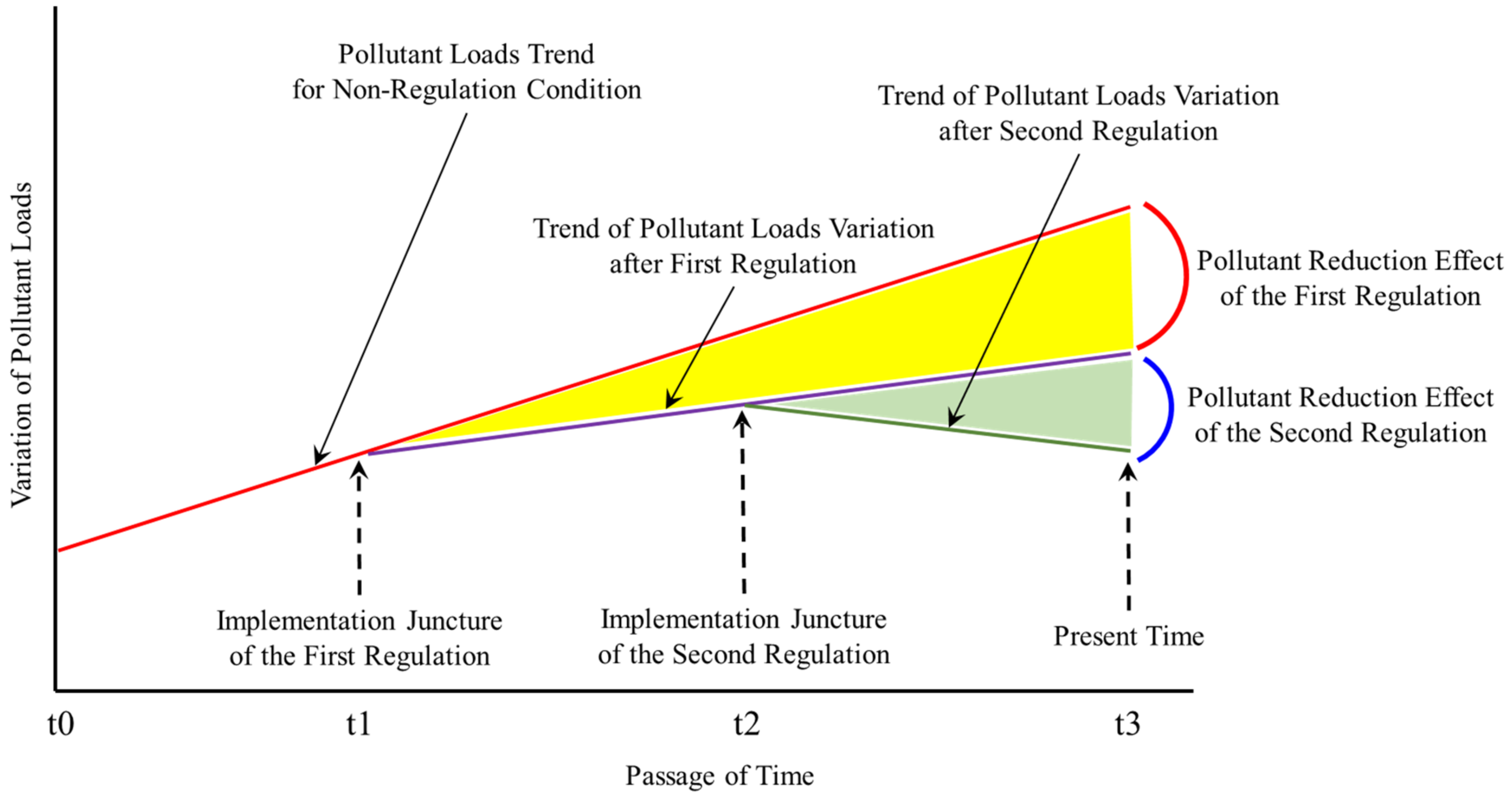
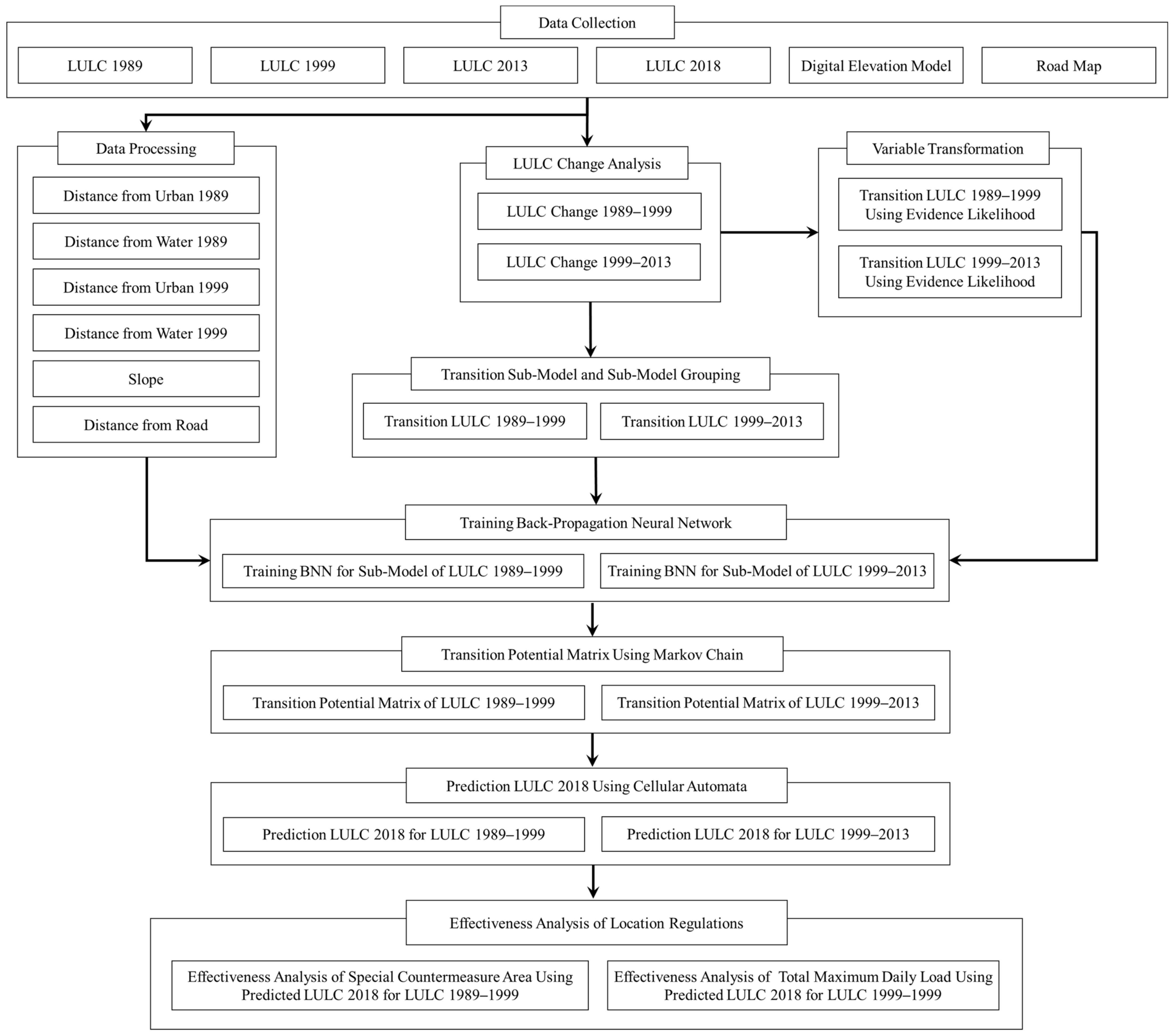
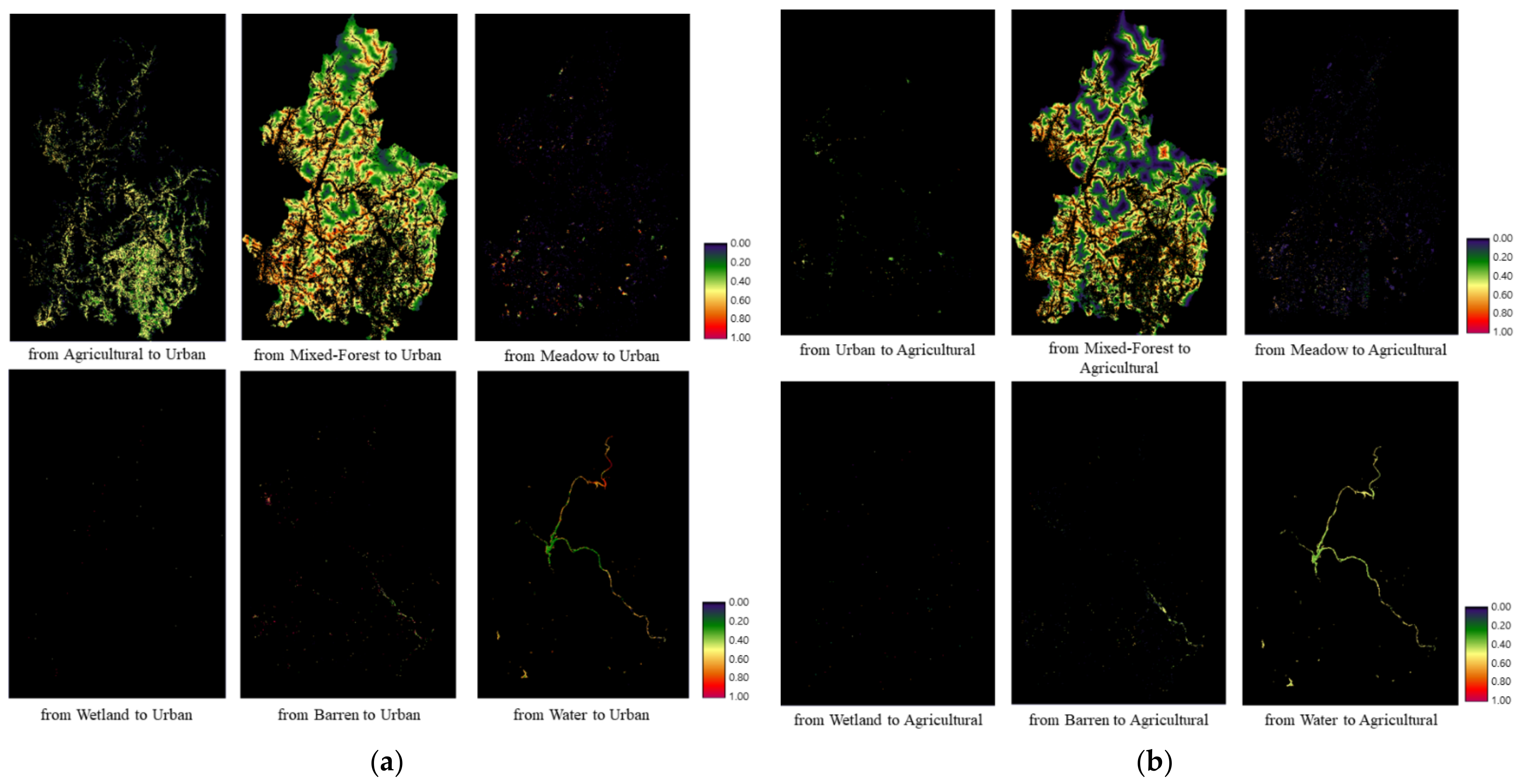
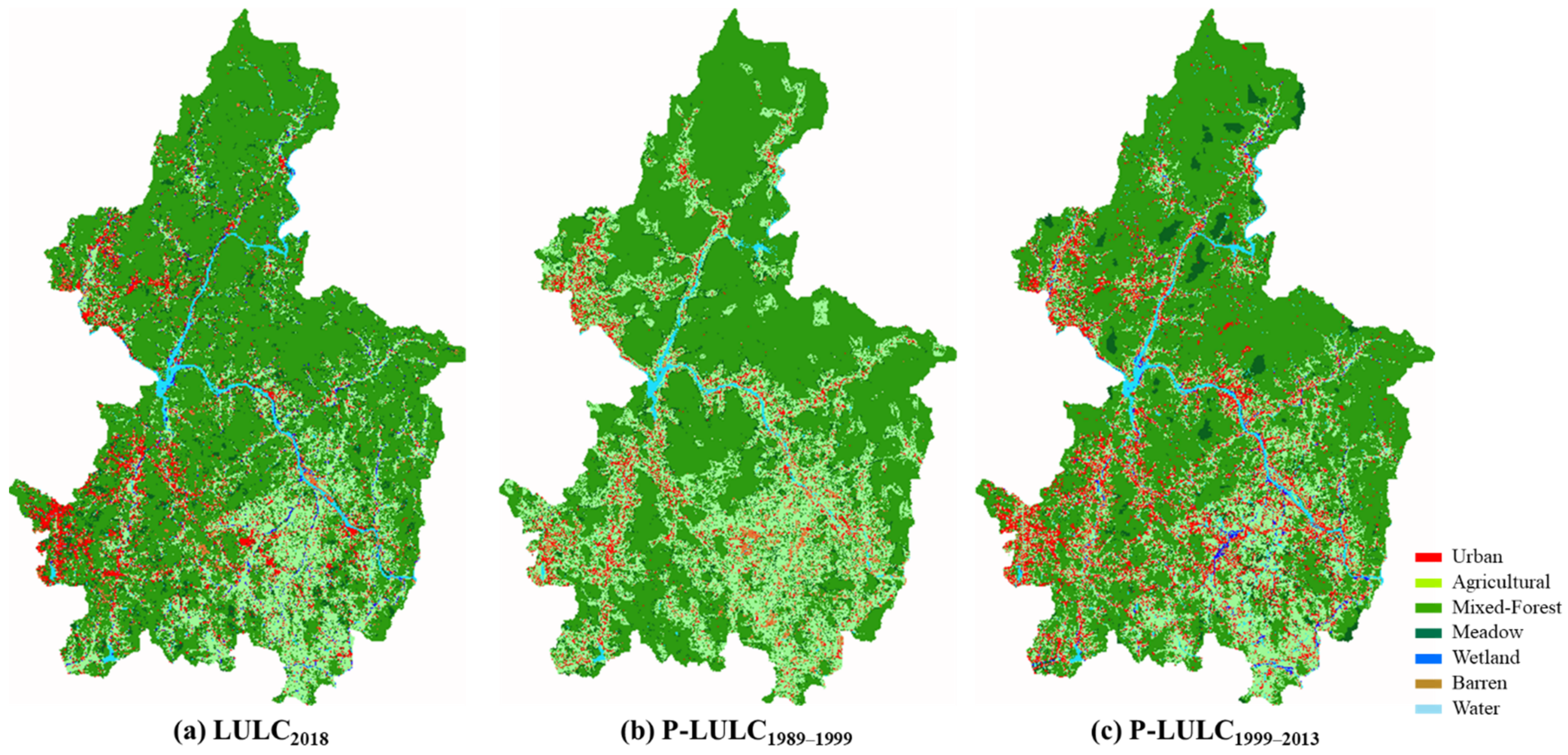
| LULC in 2018 | Area (km2) | Proportion (%) | Description |
|---|---|---|---|
| Total | 4260.9 | 100.0 | |
| Urban | 248.7 | 5.8 | Refers to areas where the ground surface is paved, including residential areas, industrial areas, commercial areas, areas used by traffic, and public facilities. |
| Agricultural | 790.7 | 18.6 | Includes farmland such as fields and paddies. |
| Mixed Forest | 2606.4 | 61.2 | Refers to forest in which both softwood and hardwood trees grow. |
| Meadow | 361.6 | 8.5 | Includes natural pastures, golf courses, cemeteries, and other types of pasture. |
| Wetland | 42.7 | 1.0 | Includes inland wetlands and waterfront vegetation areas. |
| Barren | 105.7 | 2.5 | Refers to land in which no plants grow due to the presence of rock, sand, or clay. |
| Water | 105.1 | 2.5 | Includes rivers, dams, lakes, and agricultural watercourses. |
| Contents | Type | Source | Resolution and Spatial Reference |
|---|---|---|---|
| LULC 1989 | Raster | EGIS | (30 m × 30 m), UTM-52 N |
| LULC 1999 | Raster | EGIS | (30 m × 30 m), UTM-52 N |
| LULC 2013 | Raster | EGIS | (30 m × 30 m), UTM-52 N |
| LULC 2018 | Raster | EGIS | (30 m × 30 m), UTM-52 N |
| Digital Elevation Model | Raster | WAMIS | (30 m × 30 m), UTM-52 N |
| Road Map | Shape | NTIC | UTM-52 N |
| LULC | Biochemical Oxygen Demand (kg·km−2·day−1) | Total Nitrogen (kg·km−2·day−1) | Total Phosphorus (kg·km−2·day−1) |
|---|---|---|---|
| Urban | 85.90 | 13.69 | 2.10 |
| Agricultural | 1.95 | 8.00 | 0.425 |
| Mixed Forest | 0.93 | 2.20 | 0.14 |
| Miscellaneous Land | 0.960 | 0.759 | 0.027 |
| LULC | LULC in 1989 (km2) | Losses and Gains during 1989–1999 (km2) | |||||||||
|---|---|---|---|---|---|---|---|---|---|---|---|
| Area (km2) | Proportion (%) | Losses | Gains | Net Change | |||||||
| Urban | 31.4 | 0.7 | −17.6 | 71.2 | 53.5 | ||||||
| Agricultural | 968.9 | 22.7 | −328.9 | 414.9 | 86.0 | ||||||
| Mixed-Forest | 2936.2 | 68.9 | −411.3 | 269.9 | −141.4 | ||||||
| Meadow | 216.2 | 5.1 | −195.1 | 160.3 | −34.8 | ||||||
| Wetland | 0.2 | 0.0 | −0.2 | 0.2 | 0.0 | ||||||
| Barren | 43.2 | 1.0 | −32.6 | 73.5 | 40.9 | ||||||
| Water | 64.8 | 1.5 | −12.6 | 8.4 | −4.2 | ||||||
| Total | 4260.9 | 100.0 | −998.4 | 998.4 | - | ||||||
| Contributors to Net Changes Experienced During the Period 1989–1999 (km2) | |||||||||||
| LULC | Urban | Agricultural | Mixed-Forest | Meadow | Wetland | Barren | Water | ||||
| Urban | 0.0 | −32.4 | −14.8 | −5.1 | 0.0 | −0.9 | −0.5 | ||||
| Agricultural | 32.4 | 0.0 | −98.8 | −37.9 | 0.0 | 23.3 | −4.8 | ||||
| Mixed-Forest | 14.8 | 98.8 | 0.0 | 9.1 | 0.0 | 17.2 | 1.6 | ||||
| Meadow | 5.1 | 37.9 | −9.1 | 0.0 | 0.0 | 0.7 | 0.2 | ||||
| Wetland | 0.0 | 0.0 | −0.0 | 0.0 | 0.0 | 0.0 | 0.0 | ||||
| Barren | 0.9 | −23.3 | −17.2 | −0.7 | −0.0 | 0.0 | −0.6 | ||||
| Water | 0.5 | 4.8 | −1.6 | −0.2 | 0.0 | 0.6 | 0.0 | ||||
| LULC | 1999 (km2) | 1999–2013 (km2) | |||||||||
|---|---|---|---|---|---|---|---|---|---|---|---|
| Area (km2) | Proportion (%) | Losses | Gains | Net Change | |||||||
| Urban | 84.9 | 2.0 | −36.9 | 274.5 | 237.2 | ||||||
| Agricultural | 1054.9 | 24.8 | −464.9 | 300.0 | −164.9 | ||||||
| Mixed-Forest | 2794.8 | 65.6 | −450.6 | 260.9 | −189.7 | ||||||
| Meadow | 181.4 | 4.3 | −145.8 | 179.4 | 33.6 | ||||||
| Wetland | 0.2 | 0.0 | −0.2 | 17.3 | 17.1 | ||||||
| Barren | 84.1 | 2.0 | −75.9 | 77.5 | 1.6 | ||||||
| Water | 60.7 | 1.4 | −5.2 | 70.2 | 65.0 | ||||||
| Total | 4260.9 | 100.0 | −1179.4 | 1179.4 | - | ||||||
| Contributors to the Net Changes Experienced During the Period 1989–1999 (km2) | |||||||||||
| 1999–2013 LULC | Urban | Agricultural | Mixed-Forest | Meadow | Wetland | Barren | Water | ||||
| Urban | 0.0 | −129.3 | −72.9 | −21.3 | 1.0 | −17.8 | 3.0 | ||||
| Agricultural | 129.3 | 0.0 | −31.1 | 8.9 | 10.7 | 7.9 | 39.1 | ||||
| Mixed-Forest | 72.9 | 31.1 | 0.0 | 49.3 | 1.6 | 21.3 | 13.6 | ||||
| Meadow | 21.3 | −8.9 | −49.3 | 0.0 | 0.8 | −0.9 | 3.5 | ||||
| Wetland | −1.0 | −10.7 | −1.6 | −0.8 | 0.0 | −2.2 | −0.9 | ||||
| Barren | 17.8 | −7.9 | −21.3 | 0.9 | 2.2 | 0.0 | 6.7 | ||||
| Water | −3.0 | −39.1 | −13.6 | −3.5 | 0.9 | −6.7 | 0.0 | ||||
| Grouping Transition Sub-Model (7 Sub-Models) | ||
|---|---|---|
| No. | Name | Description |
| 1 | Urban_TS | Transition from Agricultural, Mixed-Forest, Meadow, Wetland, Barren, and Water to Urban |
| 2 | Agricultural_TS | Transition from Urban, Mixed-Forest, Meadow, Wetland, Barren, and Water to Agricultural |
| 3 | Mixed-Forest_TS | Transition from Urban, Agricultural, Meadow, Wetland, Barren, and Water to Mixed-Forest |
| 4 | Meadow_TS | Transition from Urban, Agricultural, Mixed-Forest, Wetland, Barren, and Water to Meadow |
| 5 | Wetland_TS | Transition from Urban, Agricultural, Mixed-Forest, Meadow, Barren, and Water to Wetland |
| 6 | Barren_TS | Transition from Urban, Agricultural, Mixed-Forest, Meadow, Wetland, and Water to Barren |
| 7 | Water_TS | Transition from Urban, Agricultural, Mixed-Forest, Meadow, Wetland, and Barren to Water |
| Transition Sub-Models | Accuracy (%) | Training RMS | Test RMS | |
|---|---|---|---|---|
| 1989–1999 Transition sub-model | Urban_TS | 0.7562 | 0.2206 | 0.2216 |
| Agricultural_TS | 0.8446 | 0.2255 | 0.2270 | |
| Mixed-Forest_TS | 0.7578 | 0.2365 | 0.2386 | |
| Meadow_TS | 0.7728 | 0.2496 | 0.2547 | |
| Wetland_TS | 0.9327 | 0.2230 | 0.2335 | |
| Barren_TS | 0.8368 | 0.2189 | 0.2201 | |
| Water_TS | 0.9367 | 0.2228 | 0.2384 | |
| 1999–2013 Transition sub-model | Urban_TS | 0.7508 | 0.2351 | 0.2393 |
| Agricultural_TS | 0.8266 | 0.2248 | 0.2252 | |
| Mixed-Forest_TS | 0.7808 | 0.2289 | 0.2302 | |
| Meadow_TS | 0.7898 | 0.2223 | 0.2258 | |
| Wetland_TS | 0.7853 | 0.2300 | 0.2386 | |
| Barren_TS | 0.8340 | 0.2172 | 0.2287 | |
| Water_TS | 0.8764 | 0.2145 | 0.2256 | |
| TPM | LULC | Probability of Change | ||||||
|---|---|---|---|---|---|---|---|---|
| Urban | Agricultural | Mixed-Forest | Meadow | Wetland | Barren | Water | ||
| TPM 1989–1999 | Urban | 0.2316 | 0.4646 | 0.1386 | 0.0627 | 0.0002 | 0.0873 | 0.0150 |
| Agricultural | 0.0564 | 0.5262 | 0.3039 | 0.0621 | 0.0000 | 0.0464 | 0.0050 | |
| Mixed-Forest | 0.0123 | 0.1589 | 0.7771 | 0.0365 | 0.0000 | 0.0126 | 0.0026 | |
| Meadow | 0.0414 | 0.4120 | 0.4476 | 0.0565 | 0.0001 | 0.0361 | 0.0063 | |
| Wetland | 0.0898 | 0.4458 | 0.2374 | 0.0578 | 0.0002 | 0.0555 | 0.1135 | |
| Barren | 0.0882 | 0.4818 | 0.1993 | 0.0844 | 0.0001 | 0.0987 | 0.0476 | |
| Water | 0.0213 | 0.1709 | 0.0752 | 0.0217 | 0.0005 | 0.0455 | 0.6649 | |
| Sum | 0.5410 | 2.6602 | 2.1791 | 0.3817 | 0.0011 | 0.3821 | 0.8549 | |
| Sum-Itself | 0.3094 | 2.134 | 1.402 | 0.3252 | 0.0009 | 0.2834 | 0.1900 | |
| TPM 1999–2013 | Urban | 0.7362 | 0.1342 | 0.0051 | 0.0479 | 0.0126 | 0.0496 | 0.0144 |
| Agricultural | 0.0908 | 0.7280 | 0.0845 | 0.0434 | 0.0104 | 0.0286 | 0.0143 | |
| Mixed-Forest | 0.0049 | 0.0333 | 0.9228 | 0.0314 | 0.0000 | 0.0076 | 0.0000 | |
| Meadow | 0.1159 | 0.2324 | 0.2707 | 0.3262 | 0.0013 | 0.0478 | 0.0057 | |
| Wetland | 0.5387 | 0.0872 | 0.0000 | 0.0822 | 0.0843 | 0.0507 | 0.1571 | |
| Barren | 0.2603 | 0.2881 | 0.0522 | 0.1247 | 0.0415 | 0.1646 | 0.0688 | |
| Water | 0.0000 | 0.0000 | 0.0009 | 0.0062 | 0.0116 | 0.0160 | 0.9653 | |
| Sum | 1.7466 | 1.5032 | 1.3362 | 0.6620 | 0.1617 | 0.3649 | 1.2256 | |
| Sum-Itself | 1.0104 | 0.7752 | 0.4134 | 0.3358 | 0.0774 | 0.2003 | 0.2603 | |
| LULC | (a) LULC2018 (km2) | (b) P-LULC1989–1999 (km2) | (c) P-LULC1999–2013 (km2) | Difference_1 (km2) (b)–(a) | Difference_2 (km2) (c)–(a) |
|---|---|---|---|---|---|
| Urban | 248.7 (5.8%) | 146.9 (3.4%) | 417.9 (9.8%) | −101.8 | 169.2 |
| Agricultural | 790.7 (18.6%) | 1169.7 (27.5%) | 852.4 (20.0%) | 379.0 | 61.8 |
| Mixed-Forest | 2607.4 (61.2%) | 2595.3 (60.9%) | 2543.8 (59.7%) | −12.12 | −63.6 |
| Meadow | 361.6 (8.5%) | 185.6 (4.4%) | 202.8 (4.8%) | −176.0 | −158.8 |
| Wetland | 42.7 (1.0%) | 0.2 (0.0%) | 26.6 (0.6%) | −42.5 | −16.1 |
| Barren | 105.7 (2.5%) | 113.1 (2.7%) | 73.2 (1.7%) | 7.4 | −32.5 |
| Water | 104.1 (2.4%) | 50.1 (1.2%) | 144.2 (3.4%) | −54.0 | 40.1 |
| Sum | 4260.9 (100.0%) | 4260.9 (100.0%) | 4260.9 (100.0%) | 0.0 | 0.0 |
| LULC | (a) Pollutant Load Difference between P-LULC1989–1999 and P-LULC1999–2013 | ||
| Biochemical Oxygen Demand (kg·km−2·day−1) | Total Nitrogen (kg·km−2·day−1) | Total Phosphorus (kg·km−2·day−1) | |
| Urban | −23,283.2 | −3710.7 | −569.2 |
| Agricultural | 618.6 | 2537.7 | 134.8 |
| Mixed-Forest | 47.9 | 113.3 | 7.2 |
| Meadow | −16.5 | −13.0 | −0.5 |
| Wetland | −25.3 | −20.0 | −0.7 |
| Barren | 38.4 | 30.3 | 1.1 |
| Water | −90.3 | −71.4 | −2.5 |
| SUM | −22,710.5 | −1133.9 | −429.8 |
| LULC | (b) Pollutant load difference between P-LULC1999–2013 and LULC2018 | ||
| Biochemical Oxygen Demand (kg·km−2·day−1) | Total Nitrogen (kg·km−2·day−1) | Total Phosphorus (kg·km−2·day−1) | |
| Urban | 14,535.2 | 2316.5 | 355.3 |
| Agricultural | 120.4 | 494.1 | 26.3 |
| Mixed-Forest | −59.2 | −139.9 | −8.9 |
| Meadow | −152.4 | −120.5 | −4.3 |
| Wetland | −15.5 | −12.2 | −0.4 |
| Barren | −31.2 | −24.7 | −0.9 |
| Water | 38.5 | 30.4 | 1.1 |
| SUM | 14,435.7 | 2543.6 | 368.2 |
Publisher’s Note: MDPI stays neutral with regard to jurisdictional claims in published maps and institutional affiliations. |
© 2021 by the author. Licensee MDPI, Basel, Switzerland. This article is an open access article distributed under the terms and conditions of the Creative Commons Attribution (CC BY) license (https://creativecommons.org/licenses/by/4.0/).
Share and Cite
Song, C.-M. Analysis of the Effects of Local Regulations on the Preservation of Water Resources Using the CA-Markov Model. Sustainability 2021, 13, 5652. https://doi.org/10.3390/su13105652
Song C-M. Analysis of the Effects of Local Regulations on the Preservation of Water Resources Using the CA-Markov Model. Sustainability. 2021; 13(10):5652. https://doi.org/10.3390/su13105652
Chicago/Turabian StyleSong, Chul-Min. 2021. "Analysis of the Effects of Local Regulations on the Preservation of Water Resources Using the CA-Markov Model" Sustainability 13, no. 10: 5652. https://doi.org/10.3390/su13105652
APA StyleSong, C.-M. (2021). Analysis of the Effects of Local Regulations on the Preservation of Water Resources Using the CA-Markov Model. Sustainability, 13(10), 5652. https://doi.org/10.3390/su13105652





